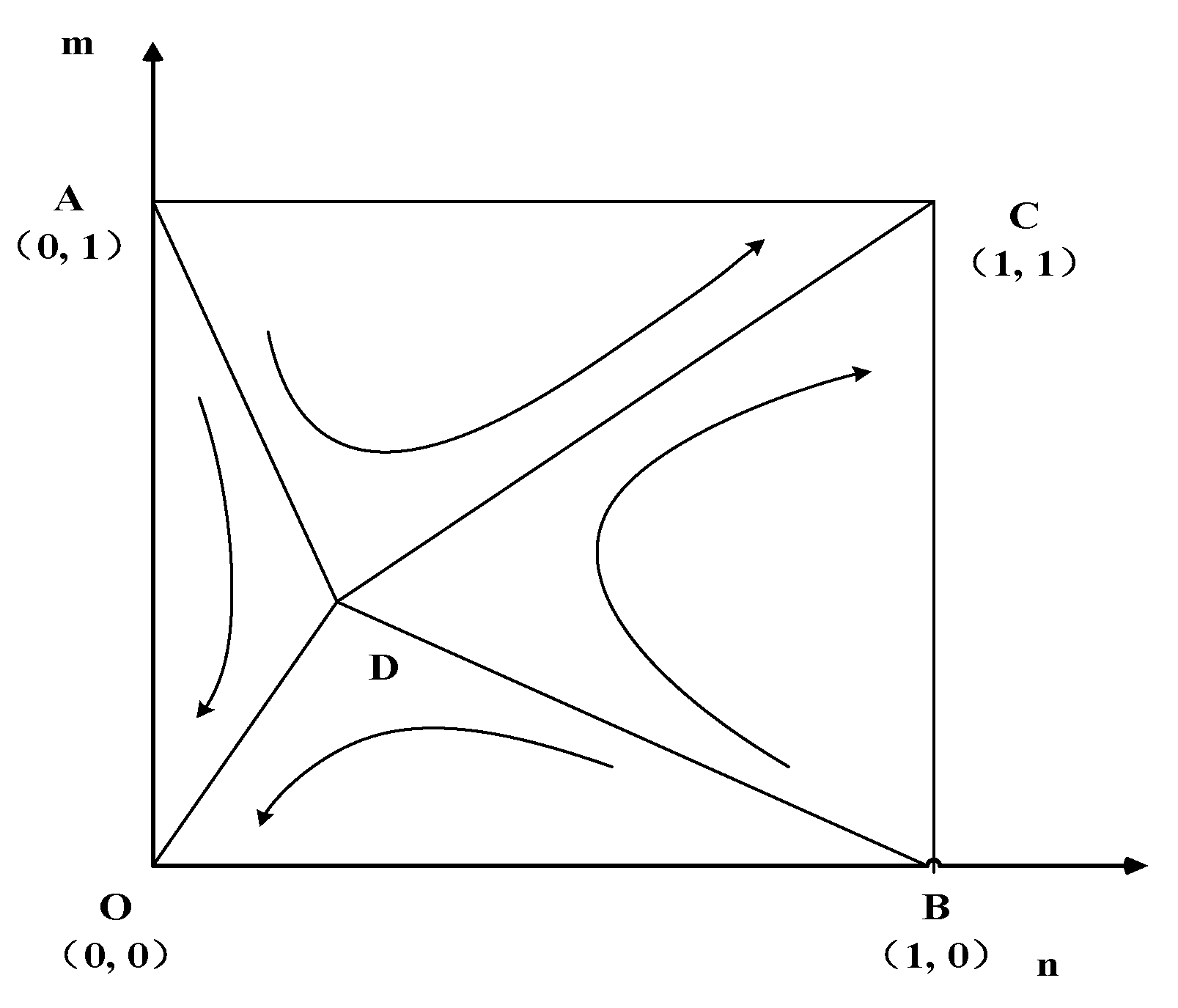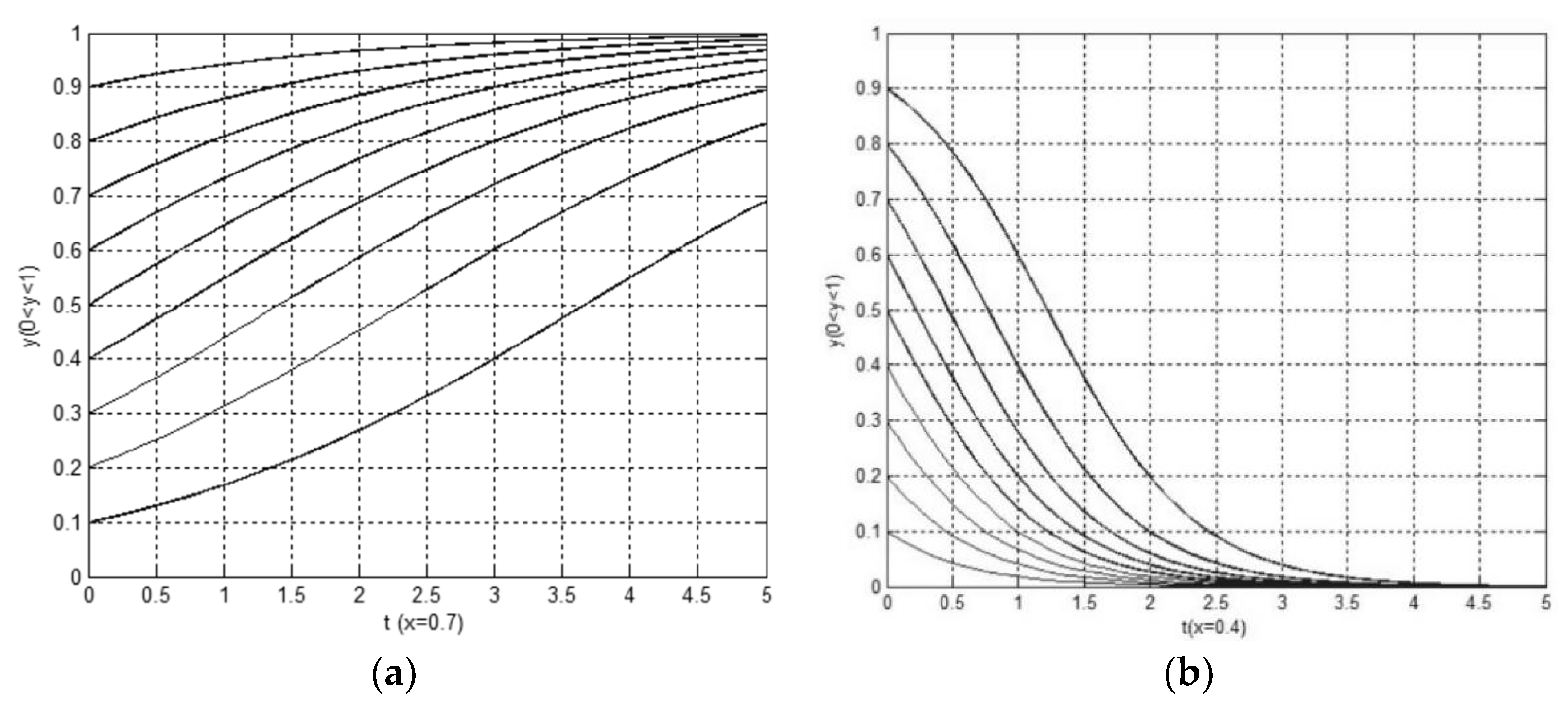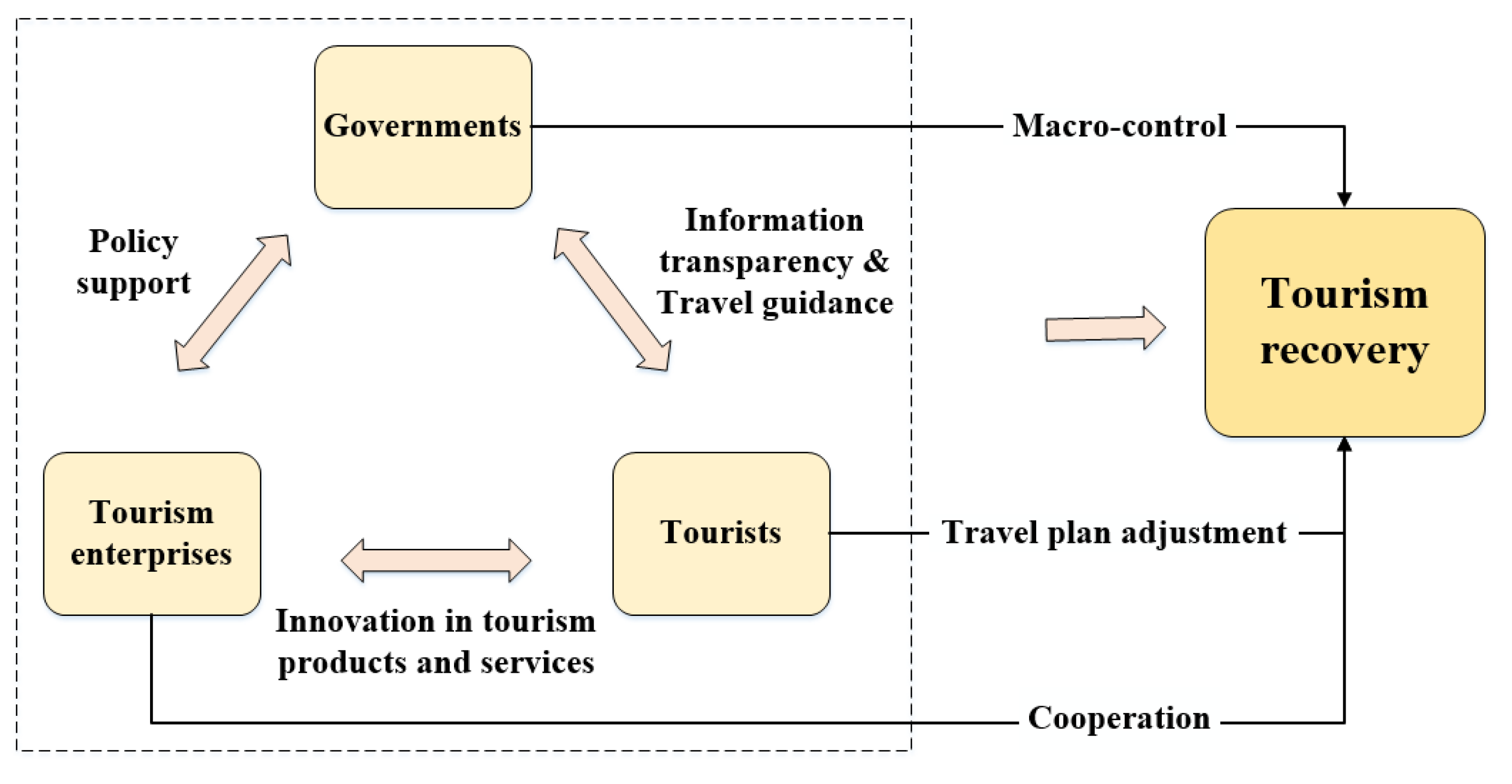Exploring Tourism Recovery in the Post-COVID-19 Period: An Evolutionary Game Theory Approach
Abstract
1. Introduction
- What changes have taken place in tourism enterprises, governments and tourists under the impact of the pandemic?
- Under the influence of different parameters, what is the possible behavioral evolution of these stakeholders?
- What should stakeholders do under the optimal evolutionary path (tourism recovery)?
2. Literature Review
2.1. Tourism Crises
2.2. Stakeholders and Tourism Recovery
2.3. The Application of Evolutionary Game Theory
3. Model Description
3.1. Background of the Model
3.2. The Evolution Model of Stakeholders in the Post-COVID-19 Period
3.2.1. Model Description between Governments and Tourism Enterprises
- (I)
- We denote x as the probability of governments selecting regulation strategy and as the probability of governments selecting a non-regulation strategy. In addition, y is the probability of tourism enterprises selecting innovative strategies for adapting to the pandemic, and is the probability of choosing to maintain the traditional development pattern before the pandemic.
- (II)
- When governments choose to implement the decision to support tourism enterprises, there will be a corresponding cost (). Tourism enterprises will be punished by governments () when their non-compliance behavior affects safe production and operation activities, whereas they will be rewarded for initiating reform and innovation (). When enterprises choose to reform and innovate tourism products and services, the corresponding cost is, and the operating income obtained is . The cost for tourism enterprises not changing their minds and choosing to maintain the traditional development trajectory before the pandemic is , and the operating income obtained by traditional methods is . When tourism enterprises choose traditional methods of development, social losses, such as pollution and safety accidents, will require governments to pay corresponding governance costs (). Table 1 explains the payoff values.
3.2.2. Model Description between Tourism Enterprises and Tourists
- (I)
- We denote y as the probability of tourism enterprises selecting innovative strategies for adapting to the pandemic, and () as the probability of choosing to maintain the traditional development pattern before the pandemic. The tourists’ strategic choice is to travel or not to travel, and the selection probabilities are given respectively by and .
- (II)
- When enterprises choose to reform and innovate tourism products and services, the corresponding cost is, and the operating income obtained is , and if the tourists support getting extra income of . The cost for tourism enterprises cannot change their minds and choose to maintain the traditional development trajectory before the pandemic is , and the operating income obtained by traditional methods is . As for tourists, the cost of the travel strategy is , the additional experience benefit obtained during the enterprise innovation is , and the experience benefit of the enterprise maintaining the traditional operating mode is . Table 2 explains the payoff values.
3.2.3. Model Description amongst Tourism Enterprises
- (I)
- The enterprise is the subject of limited rationality, and the strategic choice of the participants of the game (assuming tourism enterprise A and tourism enterprise B) can either be cooperation or non-cooperation. The probability of enterprise A choosing cooperative strategy is , and the probability of adopting non-cooperative strategy is , where . The probabilities of enterprise B choosing cooperation and non-cooperation strategies are and , respectively, where .
- (II)
- When both participants choose the non-cooperative strategy, their respective benefits are and . When both participants choose the cooperation strategy, the incremental benefit they can get is , and is the change in their respective returns when the two strategy choices are opposite. That is, the non-cooperative enterprise can obtain an incremental income of , whilst the enterprise that adopts the cooperation strategy produces a loss of, assuming that . Table 3 explains the payoff values.
4. Model Solutions
4.1. ESS Analysis amongst Stakeholders
4.2. Strategy Stability Analysis
5. Discussion
5.1. Discussion of Model Results
5.1.1. Model Result between Governments and Tourism Enterprises
5.1.2. Model Result between Tourism Enterprises and Tourists
5.1.3. Model Results amongst Tourism Enterprises
5.2. Theoretical Implications
5.3. Managerial Implications
6. Conclusions, Limitations and Directions for Future Research
Author Contributions
Funding
Institutional Review Board Statement
Informed Consent Statement
Data Availability Statement
Conflicts of Interest
References
- Yang, R.; Du, G.; Duan, Z.; Du, M.; Miao, X.; Tang, Y. Knowledge System Analysis on Emergency Management of Public Health Emergencies. Sustainability 2020, 12, 4410. [Google Scholar] [CrossRef]
- Zenker, S.; Kock, F. The coronavirus pandemic—A critical discussion of a tourism research agenda. Tour. Manag. 2020, 81, 104164. [Google Scholar] [CrossRef]
- How Are Countries Supporting Tourism Recovery? Available online: https://webunwto.s3.eu-west-1.amazonaws.com/s3fs-public/2020-06/BFN_V4.pdf (accessed on 30 June 2020).
- ICC and World Travel & Tourism Council. Issue COVID-19 Restart Guide for the Travel & Tourism Sector. Available online: https://wttc.org/News-Article/ICC-and-World-Travel-and-Tourism-Council-issue-COVID-19-restart-guide-for-the-Travel-and-Tourism-sector (accessed on 30 August 2020).
- Li, F. A comparative study on the effect of tourism crisis events with different nature based on background line—A case study of four tourism crisis events in China. Tour. Trib. 2009, 24, 73–78. [Google Scholar]
- Scott, N.; Laws, E. Tourism crises and disasters: Enhancing understanding of system impacts. J. Travel Tour. Mark. 2006, 19, 149–158. [Google Scholar] [CrossRef]
- Chien, P.M.; Ritchie, B.W. Understanding intergroup conflicts in tourism. Ann. Tour. Res. 2018, 72, 177–179. [Google Scholar] [CrossRef]
- Wang, I.M.; Ackerman, J.M. The infectiousness of crowds: Crowding experiences are amplified by pathogen threats. Pers. Soc. Psychol. Bull. 2019, 45, 120–132. [Google Scholar] [CrossRef]
- Johannisson, B.; Olaison, L. The moment of truth—Reconstructing entrepreneurship and social capital in the eye of the storm. Rev. Soc. Econ. 2007, 65, 55–78. [Google Scholar] [CrossRef]
- Page, S.; Song, H.; Wu, D.C. Assessing the impacts of the global economic crisis and swine flu on inbound tourism demand in the United Kingdom. J. Travel Res. 2012, 51, 142–153. [Google Scholar] [CrossRef]
- Seabra, C.; Reis, P.; Abrantes, J.L. The influence of terrorism in tourism arrivals: A longitudinal approach in a Mediterranean country. Ann. Tour. Res. 2020, 80, 102811. [Google Scholar] [CrossRef]
- Page, S.J.; Yeoman, I.; Munro, C.; Connell, J.; Walker, L. A case study of best practice-Visit Scotland’s prepared response to an influenza pandemic. Tour. Manag. 2006, 27, 361–393. [Google Scholar] [CrossRef]
- Zeng, B.; Carter, R.W.; De Lacy, T. Short-term perturbations and tourism effects: The case of SARS in China. Curr. Issues Tour. 2005, 8, 306–322. [Google Scholar] [CrossRef]
- Rittichainuwat, B.N.; Chakraborty, G. Perceived travel risks regarding terrorism and disease: The case of Thailand. Tour. Manag. 2009, 30, 410–418. [Google Scholar] [CrossRef]
- Cahyanto, I.; Wiblishauser, M.; Pennington-Gray, L.; Schroeder, A. The dynamics of travel avoidance: The case of Ebola in the U.S. Tour. Manag. Perspect. 2016, 20, 195–203. [Google Scholar] [CrossRef]
- Novelli, M.; Burgess, L.G.; Jones, A.; Ritchie, B.W. “No Ebola…still doomed”—The Ebola-induced tourism crisis. Ann. Tour. Res. 2018, 70, 76–87. [Google Scholar] [CrossRef]
- Williamson, J.; Hassanli, N.; Grabowski, S. OzNomads: A case study examining the challenges of COVID-19 for a community of lifestyle travellers. Curr. Issues Tour. 2021, 2021, 1928009. [Google Scholar]
- Yang, Y.; Zhang, H.; Chen, X. Coronavirus pandemic and tourism: Dynamic stochastic general equilibrium modeling of infectious disease outbreak. Ann. Tour. Res. 2020, 83, 102913. [Google Scholar] [CrossRef]
- Liu, B.; Pennington-Gray, L.; Krieger, J. Tourism crisis management: Can the Extended Parallel Process Model be used to understand crisis responses in the cruise industry? Tour. Manag. 2016, 55, 310–321. [Google Scholar] [CrossRef]
- Luo, Q.; Zhai, X. “I will never go to Hong Kong again!” How the secondary crisis communication of “Occupy Central” on Weibo shifted to a tourism boycott. Tour. Manag. 2017, 62, 159–172. [Google Scholar] [CrossRef]
- Aliperti, G.; Sandholz, S.; Hagenlocher, M.; Rizzi, F.; Frey, M.; Garschagen, M. Tourism, crisis, disaster: An interdisciplinary approach. Ann. Tour. Res. 2019, 79, 102808. [Google Scholar] [CrossRef]
- Uğur, N.G.; Akbıyık, A. Impacts of COVID-19 on global tourism industry: A cross-regional comparison. Tour. Manag. Perspect. 2020, 36, 100744. [Google Scholar] [CrossRef]
- Zhang, G. Public crisis management and government responsibility—A case study of SARS epidemic management. Manag. World 2004, 12, 42–50. [Google Scholar]
- Li, J.; Nguyen, T.H.H.; Coca-Stefaniak, J.A. Coronavirus impacts on post-pandemic planned travel behaviours. Ann. Tour. Res. 2020, 2020, 102964. [Google Scholar] [CrossRef]
- Ellis, S.; Sheridan, L. A critical reflection on the role of stakeholders in sustainable tourism development in least-developed countries. Tour. Plan. Dev. 2014, 11, 467–471. [Google Scholar] [CrossRef]
- Hystad, P.W.; Keller, P.C. Towards a destination tourism disaster management framework: Long-term lessons from a forest fire disaster. Tour. Manag. 2008, 29, 151–162. [Google Scholar] [CrossRef]
- Jiang, Y.; Ritchie, B.W. Disaster collaboration in tourism: Motives, impediments and success factors. J. Hosp. Tour. Manag. 2017, 31, 70–82. [Google Scholar] [CrossRef]
- Freeman, R.E. Strategic Management: A Stakeholder Approach; Cambridge University Press: Cambridge, UK, 2010; ISBN 978-052-115-1-740. [Google Scholar]
- Baggio, R.; Scott, N.; Cooper, C. Improving tourism destination governance: A complexity science approach. Tour. Rev. 2010, 65, 51–60. [Google Scholar] [CrossRef]
- Leiper, N. Tourism Management, 3rd ed.; Pearson Education: Sydney, Australia, 2004; ISBN 186-250-5-330. [Google Scholar]
- Waligo, V.; Clarke, J.; Hawkins, R. Embedding stakeholders in sustainable tourism strategies. Ann. Tour. Res. 2015, 55, 90–93. [Google Scholar] [CrossRef]
- Kock, F.; Nørfelt, A.; Josiassen, A.; Assaf, A.G.; Tsionas, M.G. Understanding the COVID-19 tourist psyche: The evolutionary tourism paradigm. Ann. Tour. Res. 2020, 85, 103053. [Google Scholar] [CrossRef]
- Hjalager, A.M. Repairing innovation defectiveness in tourism. Tour. Manag. 2002, 23, 465–474. [Google Scholar] [CrossRef]
- Sundbo, J.; Orfila-Sintes, F.; Sørensen, F. The innovative behaviour of tourism firms—Comparative studies of Denmark and Spain. Res. Policy 2007, 36, 88–106. [Google Scholar] [CrossRef]
- Cashdan, E.; Steele, M. Pathogen prevalence, group bias, and collectivism in the standard cross-cultural sample. Hum. Nat. 2013, 24, 59–75. [Google Scholar] [CrossRef]
- Faulkner, J.; Schaller, M.; Park, J.H.; Duncan, L.A. Evolved disease-avoidance mechanisms and contemporary xenophobic attitudes. Group Process. Intergroup Relat. 2004, 7, 333–353. [Google Scholar] [CrossRef]
- LeMoyne, É.; Chen, S.L.; Coursaris, C.K.; Sénécal, S.; Léger, P.M. The unintended consequences of COVID-19 mitigation measures on mass transit and car use. Sustainability 2020, 12, 9892. [Google Scholar] [CrossRef]
- Hatipoglu, B.; Alvarez, M.D.; Ertuna, B. Barriers to stakeholder involvement in the planning of sustainable tourism: The case of the Thrace region in Turkey. J. Clean. Prod. 2016, 111, 306–317. [Google Scholar] [CrossRef]
- Serravalle, F.; Ferraris, A.; Vrontis, D.; Thrassou, A.; Christofi, M. Augmented reality in the tourism industry: A multi-stakeholder analysis of museums. Tour. Manag. Perspect. 2019, 32, 100549. [Google Scholar] [CrossRef]
- Sheehan, L.R.; Ritchie, J.R.B. Destination stakeholders exploring identity and salience. Ann. Tour. Res. 2005, 32, 711–734. [Google Scholar] [CrossRef]
- Cai, G.; Kock, N. An evolutionary game theoretic perspective on e-collaboration: The collaboration effort and media relativeness. Eur. J. Oper. Res. 2009, 194, 821–833. [Google Scholar] [CrossRef]
- Smith, J.M.; Price, G.R. The logic of animal conflict. Nature 1973, 246, 15–18. [Google Scholar] [CrossRef]
- Li, Q.; Li, M.C.; Lv, L.; Guo, C.; Lu, K. A new prediction model of infectious diseases with vaccination strategies based on evolutionary game theory. Chaos Solitons Fractals 2017, 104, 51–60. [Google Scholar] [CrossRef]
- Wang, L.; Schuetz, C.G.; Cai, D. Choosing response strategies in social media crisis communication: An evolutionary game theory perspective. Inf. Manag. 2020, 29, 103371. [Google Scholar]
- Li, Y.; Ding, Y. Research on social trust repair of public crisis governance under network public opinion—Based on an empirical analysis of evolutionary game of animal epidemic public crisis. J. Public Manag. 2017, 14, 91–101. [Google Scholar]
- Friedman, D. Evolutionary games in economics. Econometrica 1991, 59, 637–666. [Google Scholar] [CrossRef]
- Barari, S.; Agarwal, G.; Zhang, W.J.; Mahanty, B.; Tiwari, M.K. A decision framework for the analysis of green supply chain contracts: An evolutionary game approach. Expert Syst. Appl. 2012, 39, 2965–2976. [Google Scholar] [CrossRef]
- He, P.; He, Y.; Xu, F. Evolutionary analysis of sustainable tourism. Ann. Tour. Res. 2018, 69, 76–89. [Google Scholar] [CrossRef]
- Blanco, E.; Lozano, J.; Rey-Maquieira, J. A dynamic approach to voluntary environmental contributions in tourism. Ecol. Econ. 2009, 69, 104–114. [Google Scholar] [CrossRef][Green Version]
- Smith, J.M. The theory of games and the evolution of animal conflicts. J. Theor. Biol. 1974, 47, 209–221. [Google Scholar] [CrossRef]
- Taylor, P.D.; Jonker, L.B. Evolutionarily stable strategies and game dynamics. Math. Biosci. 1978, 40, 145–156. [Google Scholar] [CrossRef]
- Zhao, L.; Chen, Z.; Liu, J. Evolutionary game theory between local government and tourism enterprises in the context of a low-carbon economy. Tour. Trib. 2015, 30, 72–82. [Google Scholar]
- Zhong, L.; Sun, S.; Law, R.; Li, X. Tourism crisis management: Evidence from COVID-19. Curr. Issues Tour. 2021, 2021, 1901866. [Google Scholar]
- Mohanty, P.; Hassan, A.; Ekis, E. Augmented reality for relaunching tourism post-COVID-19: Socially distant, virtually connected. Worldw. Hosp. Tour. Themes 2020, 12, 753–760. [Google Scholar]
- Miao, L.; Im, J.; Fu, X.; Kim, H.; Zhang, Y.E. Proximal and distal post-COVID travel behavior. Ann. Tour. Res. 2021, 88, 103159. [Google Scholar] [CrossRef]
- Chen, H.; Huang, X.; Li, Z. A content analysis of Chinese news coverage on COVID-19 and tourism. Curr. Issues Tour. 2020, 2020, 1763269. [Google Scholar] [CrossRef]
- Sigala, M. Tourism and COVID-19: Impacts and implications for advancing and resetting industry and research. J. Bus. Res. 2020, 117, 312–321. [Google Scholar] [CrossRef] [PubMed]
- Sheresheva, M.; Efremova, M.; Valitova, L.; Polukhina, A.; Laptev, G. Russian tourism enterprises’ marketing innovations to meet the COVID-19 challenges. Sustainability 2021, 13, 3756. [Google Scholar] [CrossRef]
- Fong, L.H.N.; Law, R.; Ye, B.H. Outlook of tourism recovery amid an epidemic: Importance of outbreak control by the government. Ann. Tour. Res. 2020, 25, 102951. [Google Scholar] [CrossRef]
- Cohen, E.; Neal, M. Coinciding crises and tourism in contemporary Thailand. Curr. Issues Tour. 2010, 13, 455–475. [Google Scholar] [CrossRef]
- Jenkins, C.L.; Henry, B.M. Government involvement in tourism in developing countries. Ann. Tour. Res. 1982, 9, 499–521. [Google Scholar] [CrossRef]
- Kubickova, M.; Martin, D. Exploring the relationship between government and destination competitiveness: The TALC model perspective. Tour. Manag. 2020, 78, 104040. [Google Scholar] [CrossRef]
- Rastegar, R. Tourism and justice: Rethinking the role of governments. Ann. Tour. Res. 2020, 2020, 102884. [Google Scholar] [CrossRef]
- Bramwell, B. Governance, the state and sustainable tourism: A political economy approach. J. Sustain. Tour. 2011, 19, 459–477. [Google Scholar] [CrossRef]
- Ritchie, B.W.; Jiang, Y. A review of research on tourism risk, crisis and disaster management: Launching the annals of tourism research curated collection on tourism risk, crisis and disaster management. Ann. Tour. Res. 2019, 79, 102812. [Google Scholar] [CrossRef]
- Nicola, M.; Alsafi, Z.; Sohrabi, C.; Kerwan, A.; Al-jabir, A.; Iosifidis, C.; Agha, M.; Agha, R. The socio-economic implications of the coronavirus pandemic (COVID-19): A review. Int. J. Surg. 2020, 78, 185–193. [Google Scholar] [CrossRef] [PubMed]
- Liang, Y.H.; Yang, X.J. The game-theory analysis on regional tourism cooperation and competition. Geogr. Geoinf. Sci. 2005, 21, 94–97. [Google Scholar]





| Game Agents and Their Strategies | Tourism Enterprises | ||
|---|---|---|---|
| Innovation | Traditional Development Pattern | ||
| Governments | Regulation | ||
| Non-regulation | |||
| Game Agents and Their Strategies | Tourism Enterprise | ||
|---|---|---|---|
| Innovation | Traditional Development Pattern | ||
| Tourists | Travel | ||
| No travel | |||
| Game Agents and Their Strategies | Tourism Enterprise B | ||
|---|---|---|---|
| Cooperation | Non-Cooperation | ||
| Tourism Enterprise A | Cooperation | ||
| Non-cooperation | |||
| Equilibrium Point | Local Stability | Conditions | ||
|---|---|---|---|---|
| + | - | ESS | ||
| + | - | ESS | ||
| + | - | ESS | ||
| - | / | Saddle point | / | |
| / | 0 | / | / |
| Equilibrium Point | Local Stability | Conditions | ||
|---|---|---|---|---|
| + | - | ESS | ||
| + | - | ESS | ||
| + | - | ESS | ||
| + | - | ESS | ||
| / | / | Instability | / |
| Equilibrium Point | Local Stability | ||
|---|---|---|---|
| + | - | ESS | |
| + | + | Instability | |
| + | + | Instability | |
| + | - | ESS | |
| - | 0 | Saddle point |
Publisher’s Note: MDPI stays neutral with regard to jurisdictional claims in published maps and institutional affiliations. |
© 2021 by the authors. Licensee MDPI, Basel, Switzerland. This article is an open access article distributed under the terms and conditions of the Creative Commons Attribution (CC BY) license (https://creativecommons.org/licenses/by/4.0/).
Share and Cite
Yan, H.; Wei, H.; Wei, M. Exploring Tourism Recovery in the Post-COVID-19 Period: An Evolutionary Game Theory Approach. Sustainability 2021, 13, 9162. https://doi.org/10.3390/su13169162
Yan H, Wei H, Wei M. Exploring Tourism Recovery in the Post-COVID-19 Period: An Evolutionary Game Theory Approach. Sustainability. 2021; 13(16):9162. https://doi.org/10.3390/su13169162
Chicago/Turabian StyleYan, Hui, Haixiang Wei, and Min Wei. 2021. "Exploring Tourism Recovery in the Post-COVID-19 Period: An Evolutionary Game Theory Approach" Sustainability 13, no. 16: 9162. https://doi.org/10.3390/su13169162
APA StyleYan, H., Wei, H., & Wei, M. (2021). Exploring Tourism Recovery in the Post-COVID-19 Period: An Evolutionary Game Theory Approach. Sustainability, 13(16), 9162. https://doi.org/10.3390/su13169162






